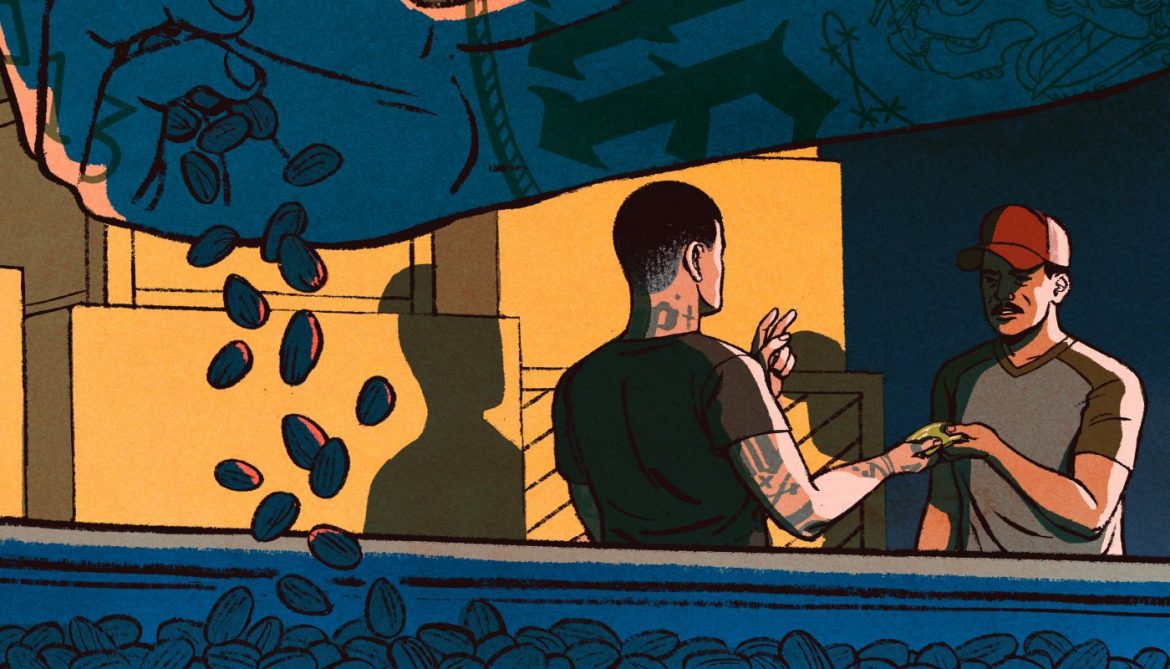
At 11:22 a.m. on Thursday, June 20, 2013, an orange Freightliner tractor-trailer arrived at Crain Walnut Shelling in Los Molinos, California. The truck’s driver, a man in his mid-thirties wearing a gray T-shirt, introduced himself as Alex Hernandez. He said he was from K and G Transport Services, a company contracted to take a load of Crain’s walnuts to Bulk Barn Foods Limited, a Canadian food retailer located 2,600 miles away in Ontario. Hernandez had arrived before the pickup had been scheduled, which initially made Crain’s logistics director suspicious. But after double-checking the paperwork that he provided, she directed employees to load 630 cartons of walnuts, worth $85,000, into Hernandez’s trailer.
At 12:06, Hernandez left Los Molinos and headed south through California’s Central Valley into Glenn County, where he picked up a second batch of walnuts intended for Bulk Barn from a processor called Carriere Family Farms. While leaving, Hernandez’s Freightliner got stuck in a field. He called a tow truck to pull it out, then drove off.
By Monday, June 24, neither batch of walnuts had arrived in Canada. A representative from the shipping brokerage that arranged the exchange tried but failed to reach K and G, and alerted Crain to the possibility that the nuts had been stolen. On June 27, Chad Parker, a then 38-year-old agricultural-crimes detective with the Tehama County Sheriff’s Office, went to investigate.
Crain’s chief financial officer showed Parker a photograph from June 20 and provided him with the Freightliner’s plate number and a photocopy of Hernandez’s commercial driver’s license. What Parker found made little sense: the plate came back registered to a different model of truck, and the license number belonged to a 30-year-old woman. Later, when Parker pulled records for the phone number Hernandez had listed on the paperwork, he found that it was a prepaid cell phone with a Miami area code. It had been activated for the first time only two days before the pickup and then disconnected on June 29. Tractor-trailers do not disappear easily, and Parker considered issuing a be-on-the-lookout for the Freightliner. But more than a month after the theft, he decided it was likely long gone.
Petty thefts of walnuts are not uncommon in central California. Several counties even ban the sale of nuts before harvest is complete, to discourage black-market sales. But the Crain theft, along with similar heists in 2011 and 2012, seemed different to Parker. They were committed by people who appeared to understand the trucking business, identity theft, and computer security. Neither of the earlier crimes had given Parker much to investigate, and at first this one looked no more promising. “I’m left holding a report saying ‘Someone showed up,’ and I’ve got a license plate that doesn’t exist,” Parker told me last winter. “They disappear into the night.”
Around the time of the Crain theft, Rich Paloma, a police officer turned reporter at the Oakdale Leader, a weekly paper based several hours south of Tehama County, began tracking high-value loads of nuts that had vanished. Paloma counted half a dozen heists, valued at more than $1 million, in the previous year. In the fall of 2013, he published an article speculating that the thefts were coordinated.
“When you look at the logistics needed to complete this crime,” he told me, all signs point toward an organized group. “You steal 370,000 pounds of almonds, you’re not going to sell it on the side of the road.”
In recent years, nut theft has exploded into a statewide problem. More than 35 loads, worth at least $10 million, have gone missing since 2013. The number and style of the thefts—quick and professional, as if the characters from Ocean’s Eleven had descended on the Central Valley—have drawn the attention of federal organized-crime investigators and prompted the creation of a regional task force.
Why steal nuts? They’re worth an awful lot of money. In 2014, the American Pistachio Growers association reported industry-wide sales of more than $1.6 billion. The organization recently signed endorsement deals with British cyclist Mark Cavendish, big-mountain snowboarder Jeremy Jones, and the U.S. water-polo teams.
California grows the majority of the world’s almonds and is the second-largest producer of pistachios and walnuts. Many environmentalists blame their cultivation for exacerbating California’s drought—nut trees are thirsty plants.
Last spring I visited the Horizon Nut Company, three hours north of L.A. in Tulare County. In November 2015, Horizon lost a load of pistachios worth $450,000. Kirk Squire, Horizon’s grower-relations manager, said that the theft was embarrassing for the company. “You have to imagine, you’re handing someone half a million dollars.”

The Horizon plant is well defended. Visitors must have escorts, and the facility is enclosed by a tall fence topped with barbed wire. When I arrived, a security guard examined my ID. Squire and I met in a waiting area near his office, where I found a bowl of roasted and salted pistachios and took a handful. Inside the processing facility, we walked by an embankment of 2,000-pound bins of pistachios. Squire showed me a series of automated laser- and X-ray-guided sorting machines and the company’s refrigerated storage warehouse, where nuts are kept for processing after being husked. The nuts in the load that went missing in 2015 retail for as much as $17.
A few hours after that theft, a Horizon employee had noticed that the driver’s paperwork was out of order and called the police. Officers eventually tracked down the man, who had already delivered the nuts and didn’t seem to know that he’d been involved in a crime. The thieves likely tricked him into delivering the load, then quickly transferred it. The nuts were never recovered.
The man tasked with finding missing nuts in Tulare County is sheriff Mike Boudreaux, and in 2015 he faced a growing problem. That year, thieves had stolen six shipments, valued at $1.6 million, from area processors, including Horizon. Recognizing a threat to the county’s economy, Boudreaux assigned half a dozen detectives to a new unit—the Nut Theft Task Force. I met most of them at a conference for nut processors in Modesto last year. The men were barrel-chested and serious, wearing jeans, cowboy boots, and blousey white dress shirts. They looked as if the department had just then switched their assignment from bailing hay to organized crime. Boudreaux said nut theft had outstripped drug crime as his top priority and promised an aggressive investigation. Shortly after the conference got under way, news arrived that another processor in Tulare had been hit, and the team excused itself to work leads by phone out in the hallway.
Scott Cornell, who heads a special unit of cargo-fraud investigators at Travelers Insurance, told the audience that food and beverages overtook electronics as the most commonly stolen cargo in 2010. “We think the bad guys learned that food is a great category,” he told me. “There’s no serial number. You can’t locate these things over the Internet. The evidence is consumed.”
In fact, food is the easiest target in an ocean of easy targets. A private investigator and transit-company owner from California named Sam Wadhwani said that he had tracked cargo thefts of tires, Xboxes, computer equipment earmarked for the military, baby formula, tampons, and iPhones. Inventing a fake trucking company is easy, he said, as is impersonating a legitimate one. The only people in the shipping industry responsible for verifying truckers are brokers, who connect customers with trucking companies. Wadhwani looked into vetting practices at a major brokerage several years ago and asked the company to describe its process. An employee said, “We ask the trucking company to send documents, we pick them up off the fax, and we file them away. We don’t look at them, we don’t read them.”
Roger Isom, president of the Western Agricultural Processors Association, said that the situation is further complicated by the fact that many nut processors have avoided contacting the police, worried that reporting thefts could jeopardize future business. “And not just the nut industry—the trucking companies, the shippers,” he said. “They don’t want to talk because they’re embarrassed.” No one is eager to be the laughing stock of the nut industry. When I visited Horizon, Squire told me that one processor, concerned about publicity, tried hiding GPS trackers in its shipments instead of calling the police. The company still lost two loads to thieves.
The closer Chad Parker looked at K and G Transport, the more he grew convinced that the Crain theft was linked to a broader conspiracy. E-mail records for K and G revealed that someone had been accessing the company’s account from public computers at libraries and Internet cafés around Los Angeles. (K and G is based in Miami.) Cargo thieves often pose as legitimate companies and bid for shipping contracts on load boards, which are sort of like Craigslist for truckers looking for jobs. A thief hoping to steal almonds might try to find transport jobs in nut-growing regions across the country, especially ones that ask truckers to be well insured or that leave late in the week, to give them a few…





